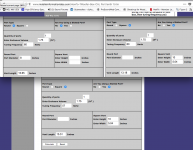Chris,I think (not certain) that the advanced centreline method still holds here. In the simulation and the drawing, the port panel is about 250mm long*, which is around half of the width of the cabinet.
With as much distance between the port and the back panel it looks like a standard BR box to me.
My bet would be on the BR model FB coming in a few Hz higher than the actual tuning, as higher aspect port shapes are the equivalent of a slightly longer circular port.
What is the Fb for the "advanced centreline method" compared to what is predicted with a standard BR model?
At any rate, if the box were mine, I'd check Fb before gluing in the port panel ;^).
I'd also make the drivers removable, if one died you could cover the hole and the box will still have the same LF response.
Art
Hey Art,
If you set the transition area as part of the cabinet volume, there's around 4Hz difference between the two - 57Hz vs 61Hz, with the simple port model being higher and the centre-line method being lower.
Not really enough to worry about, but it's interesting to see how well we can get a simple simulation to represent real subwoofer (oops, bass module) cabinets.
Are you sure removing one driver will give the same LF response?
Running the sim, it looks like it'll give a peaky response as the two remaining drivers effectively see a larger box with the same port tuning frequency.
Definitely going to check port tuning before gluing everything together.
Cheers,
Chris
If you set the transition area as part of the cabinet volume, there's around 4Hz difference between the two - 57Hz vs 61Hz, with the simple port model being higher and the centre-line method being lower.
Not really enough to worry about, but it's interesting to see how well we can get a simple simulation to represent real subwoofer (oops, bass module) cabinets.
Are you sure removing one driver will give the same LF response?
Running the sim, it looks like it'll give a peaky response as the two remaining drivers effectively see a larger box with the same port tuning frequency.
Definitely going to check port tuning before gluing everything together.
Cheers,
Chris
1) "Sub" means "below", there is no frequency response lower limit implied. When you build your box, it will be a real subwoofer with an F3 of something or other ;^).
Just did a quick set of sims (very) roughly the size of your box and port:
Port Length Calculator
The difference between the round and rectangular port length was about 16%, a 3Hz difference if port length is held to around the same lenght. That's almost the same as your two different simulations difference, "interesting :^)".
2)The two drivers should see the same size box as three other than Vd of the driver, Fb and port output should remain the same, upper output should drop by about 3 dB.
I'm curious to see what your BR sims substituting 2 for 3 look like if overlaid with the same voltage input.
3) Good plan, though with only 1/6 octave between the two predictions, as you said, "not really enough to worry about".
Just did a quick set of sims (very) roughly the size of your box and port:
Port Length Calculator
The difference between the round and rectangular port length was about 16%, a 3Hz difference if port length is held to around the same lenght. That's almost the same as your two different simulations difference, "interesting :^)".
2)The two drivers should see the same size box as three other than Vd of the driver, Fb and port output should remain the same, upper output should drop by about 3 dB.
I'm curious to see what your BR sims substituting 2 for 3 look like if overlaid with the same voltage input.
3) Good plan, though with only 1/6 octave between the two predictions, as you said, "not really enough to worry about".
Attachments
Hey Art,
Ask and you shall receive.
This is the slot-loaded ported box, since a conventional BR is a little more plain - same output at port tuning, 3dB less everywhere else. All drivers in parallel, I just removed one for the second sim.
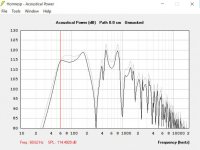
Since the slot-loaded box effectively has two tuning frequencies, that rule applies twice (60Hz and 160Hz), and we can see the 3dB difference elsewhere.
Going down to one driver makes the difference 9dB, but it holds the output up at the two tuning frequencies.
Chris
PS - I'm not certain this cabinet will go much/any lower than the main speakers, but since they'll have 1x6" driver on a stand, the 3x 6"s at ground level will provide considerably more output.
Ask and you shall receive.
This is the slot-loaded ported box, since a conventional BR is a little more plain - same output at port tuning, 3dB less everywhere else. All drivers in parallel, I just removed one for the second sim.

Since the slot-loaded box effectively has two tuning frequencies, that rule applies twice (60Hz and 160Hz), and we can see the 3dB difference elsewhere.
Going down to one driver makes the difference 9dB, but it holds the output up at the two tuning frequencies.
Chris
PS - I'm not certain this cabinet will go much/any lower than the main speakers, but since they'll have 1x6" driver on a stand, the 3x 6"s at ground level will provide considerably more output.
The boundary loading (being on the floor)will help with the low end as well. Speakers on sticks always struggle in full space.
The boundary loading (being on the floor)will help with the low end as well. Speakers on sticks always struggle in full space.
Yep, which is why all my sims for subs are in half-space (floor), unless the subs are to be flown. Tops are simulated in full-space, but if they get a bit more output from nearby boundries then I'm not going to complain.
This way, I get an idea of what the cabinets will do in worst-case conditions, and if they get a boost from certain placements then it's a bonus.
Chris
Chris,Hey Art,
Ask and you shall receive.
This is the slot-loaded ported box, since a conventional BR is a little more plain - same output at port tuning, 3dB less everywhere else. All drivers in parallel, I just removed one for the second sim.
Since the slot-loaded box effectively has two tuning frequencies, that rule applies twice (60Hz and 160Hz), and we can see the 3dB difference elsewhere.
I hadn't considered the slot tuning, so the "twin peaks" make sense. Thanks for posting.
Hornresp isn't very relyable in terms of bassreflex. Use WinISD or BassCADe or similar programs.
You might like to read the post linked below, comparing the Hornresp and WinISD models:
http://www.diyaudio.com/forums/subwoofers/311268-discrepancy-winisd-hornresponse-2.html#post5169553
Just a quick note to say I've got the first one gluing up. Should be ready for some testing in an hour or so.
I did some testing with a few different port lengths, but found it very difficult to ensure the cabinet was air-tight enough for the results to be useful. In the end, I got a couple of impedance curves that were believable, and picked the port length accordingly. The tuning frequency should be around 58Hz, which is close enough for me. So long as it's between 55Hz and 65Hz, I'll be happy.
I've gone for a pair of SpeakOn connectors on the back, with a bi-amped input (sub on 1+/-) and a HF pass-through (2+/- input goes to 1+/- on the output). Should keep cables nice and neat - 4-core input, and then a link up to the top speaker. Of course, the sub can be run alone with a 2-core cable if necessary.
Gonna have some lunch and then see what's what.
Chris
I did some testing with a few different port lengths, but found it very difficult to ensure the cabinet was air-tight enough for the results to be useful. In the end, I got a couple of impedance curves that were believable, and picked the port length accordingly. The tuning frequency should be around 58Hz, which is close enough for me. So long as it's between 55Hz and 65Hz, I'll be happy.
I've gone for a pair of SpeakOn connectors on the back, with a bi-amped input (sub on 1+/-) and a HF pass-through (2+/- input goes to 1+/- on the output). Should keep cables nice and neat - 4-core input, and then a link up to the top speaker. Of course, the sub can be run alone with a 2-core cable if necessary.
Gonna have some lunch and then see what's what.
Chris
First test was not good. Lots of air turbulence noises, even at low power. Shine a torch in there, and the top panel wasn't sealed to the baffle. Damn.
Poured a lot of glue in there, gonna give it a couple of hours to dry again, and we'll see how it looks.
Chris
Poured a lot of glue in there, gonna give it a couple of hours to dry again, and we'll see how it looks.
Chris
So, it looks like pouring a load of glue down each joint worked.
Results:
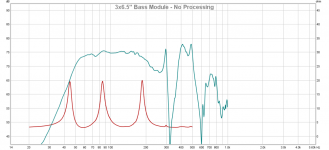
The measurement was taken indoors, with the mic placed at each port outlet, and then summed in REW. Since the ports are the same size, it should be pretty reliable. I'm hoping to take everything outdoors for some proper measurements, though the outdoor space isn't huge.
The 300Hz peak comes out of the low-frequency port. 4-500Hz is from both. If you want to cross to the mid-high cabinets above 100Hz, you'll need EQ and/or a steep crossover slope, but it's perfectly possible. The low-pass filter on the mixing desk I use is only 18dB/octave, so I'll probably use a couple of parametric EQs to ensure the peaks through the midrange don't get excited.
Chris
Results:

The measurement was taken indoors, with the mic placed at each port outlet, and then summed in REW. Since the ports are the same size, it should be pretty reliable. I'm hoping to take everything outdoors for some proper measurements, though the outdoor space isn't huge.
The 300Hz peak comes out of the low-frequency port. 4-500Hz is from both. If you want to cross to the mid-high cabinets above 100Hz, you'll need EQ and/or a steep crossover slope, but it's perfectly possible. The low-pass filter on the mixing desk I use is only 18dB/octave, so I'll probably use a couple of parametric EQs to ensure the peaks through the midrange don't get excited.
Chris
Any stuffing in the box? I'd try putting a big lump of dampening in one end/corner. Might knock those peaks down a bit but not really affect anything else.
Chris,The measurement was taken indoors, with the mic placed at each port outlet, and then summed in REW. Since the ports are the same size, it should be pretty reliable. I'm hoping to take everything outdoors for some proper measurements, though the outdoor space isn't huge.
The summed measurements look pretty good! Looks like Fb came in at the bottom of your 10Hz "window of acceptability" ;^).
Was the mic on the floor or at the center of the plenum and ports?
My bet is there are rather large differences in the upper response peaks and dips between those two measurement positions.
Looking forward to how your outdoor measurements at some distance compare to the outlet measurements.
Cheers,
Art
Hi Art,
The mic was resting on the bottom panel of the cabinet. Just a quick-and-dirty measurement to make sure everything was sealed up properly.
A quick listen suggests some EQ to knock those peaks down fixes the very "boxy" sound you get running it full-range.
Proper measurements coming soon.
Chris
The mic was resting on the bottom panel of the cabinet. Just a quick-and-dirty measurement to make sure everything was sealed up properly.
A quick listen suggests some EQ to knock those peaks down fixes the very "boxy" sound you get running it full-range.
Proper measurements coming soon.
Chris
Cheers, Mark.
Rain's forecast for the rest of the week now, but the weekend looks promising.
In the mean time, I'm going to sit one of the little PA speakers on top and see how the crossover looks. Nearfield micing, again, but with the cabinets right next to each other it should work okay.
If I'm happy with how this one plays (SPL, extension, distortion, etc) I'll build the second one and then start looking for some long speaker poles.
Chris
Rain's forecast for the rest of the week now, but the weekend looks promising.
In the mean time, I'm going to sit one of the little PA speakers on top and see how the crossover looks. Nearfield micing, again, but with the cabinets right next to each other it should work okay.
If I'm happy with how this one plays (SPL, extension, distortion, etc) I'll build the second one and then start looking for some long speaker poles.
Chris
Okay, here we go.
Had a little time to do some outdoor measurements. Sun was out, and about a million birds were singing along to the chirps coming out the speaker. I set REW to repeat each sweep eight times so I'm hopeful the background noise will be averaged out to some extent.
First up, the 1x6.5" top:
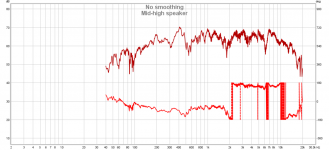
The dip around 2kHz is dependent on the height of the mic. The 400Hz peak isn't fantastic, but way better than the untreated cabinets. I've been EQing out the 400Hz peak.
Sensitivity came out at 94dB at 2.83v at 200Hz.
They're a bit bass-light, but that can be helped by putting them close to walls. The measurement here was on a stand in free space.
Next up, the sub:
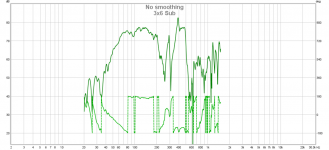
Outdoors, without close-micing, the rolloff moves up quite a way, which is a shame. The upper response is still messy.
After some playing around, I got the two to join up:
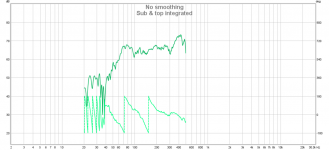
BW3 at 170Hz, LF with reversed polarity. I also added a couple of notch filters to help kill off the out-of-band mush.
With a little EQ applied to the mid-high speaker, the result is a really good sounding system. A touch short on bass extension, perhaps, but enough to give acoustic instruments (cajon etc) some grunt.
I'd like to do some high-power testing before committing to building the second bass module, but things are looking good.
Chris
Had a little time to do some outdoor measurements. Sun was out, and about a million birds were singing along to the chirps coming out the speaker. I set REW to repeat each sweep eight times so I'm hopeful the background noise will be averaged out to some extent.
First up, the 1x6.5" top:

The dip around 2kHz is dependent on the height of the mic. The 400Hz peak isn't fantastic, but way better than the untreated cabinets. I've been EQing out the 400Hz peak.
Sensitivity came out at 94dB at 2.83v at 200Hz.
They're a bit bass-light, but that can be helped by putting them close to walls. The measurement here was on a stand in free space.
Next up, the sub:

Outdoors, without close-micing, the rolloff moves up quite a way, which is a shame. The upper response is still messy.
After some playing around, I got the two to join up:

BW3 at 170Hz, LF with reversed polarity. I also added a couple of notch filters to help kill off the out-of-band mush.
With a little EQ applied to the mid-high speaker, the result is a really good sounding system. A touch short on bass extension, perhaps, but enough to give acoustic instruments (cajon etc) some grunt.
I'd like to do some high-power testing before committing to building the second bass module, but things are looking good.
Chris
Chris,Next up, the sub:
View attachment 675698
Outdoors, without close-micing, the rolloff moves up quite a way, which is a shame.. A touch short on bass extension, perhaps, but enough to give acoustic instruments (cajon etc) some grunt.
BW3 at 170Hz, LF with reversed polarity.
I'd like to do some high-power testing before committing to building the second bass module, but things are looking good.
Not bad, within a few dB of the sim at 60 Hz, should be able to get it flat to there without heroic EQ.
Not that it would make a difference unless you used these subs with others, but why reverse the LF polarity instead of the top?
Cheers,
Art
This is where the reality of small drivers in a small box trying to generate deep frequencies at reasonable efficiency begins to rear its head. Still, a reasonable 60hz is still on par with many 12 and 15" cabs on sticks so still rather usable.
Would be interesting to see how they go at high SPL with music. Also would be interested in pics, I'm contemplating a very compact system myself for house parties using something like a small array of 3" drivers and a dual 8 sub per side. Using mid efficiency 8s gets a decent 45hz bottom end at sensitivity similar to what you're getting (4 ohm sub)
Maybe Faitals little neo drivers or similar.
I made a semi compact system years ago with much bigger bass cabinets(dual 12" reflex) that actually ran up to 500hz to a dual 5" sealed back mid box with small horn tweeter(top cabs were tiny) amazing how little you missed having low mids off the ground, was actually really impressive. Was capable of pub filling noise no problem.
Would be interesting to see how they go at high SPL with music. Also would be interested in pics, I'm contemplating a very compact system myself for house parties using something like a small array of 3" drivers and a dual 8 sub per side. Using mid efficiency 8s gets a decent 45hz bottom end at sensitivity similar to what you're getting (4 ohm sub)
Maybe Faitals little neo drivers or similar.
I made a semi compact system years ago with much bigger bass cabinets(dual 12" reflex) that actually ran up to 500hz to a dual 5" sealed back mid box with small horn tweeter(top cabs were tiny) amazing how little you missed having low mids off the ground, was actually really impressive. Was capable of pub filling noise no problem.
Hi Art,
Good question. I guess I wanted the tops to be "correct" polarity, so the subs should be adjusted to integrate properly, though I can see there's no particular reason that should be the case.
Lunchietey, here's a quick photo from the measurement session yesterday:

Excuse the pallet, the grass was a bit wet.
I did run some simulations of a couple of Tang Band 6.5" mini-subs, but they really don't have the efficiency to do this.
The top-end Faital Pro 8"s are worth a look. Some of them have healthy Xmax and a good amount of thermal power handling. If I had the budget, a pair of those a side would be a lot of fun.
I did try making a column speaker with a bunch of Bose 2.5" full-range units. I found the HF to be difficult to manage well - since the column was a line array at HF, but a point source below 1kHz or so, as you moved away the tonality changed quite drastically. Leaving only the top few drivers doing HF helped with that, but then you might as well use a tweeter and do it properly.
I might revisit that, but this little system is proving rather good so far.
High-power testing is next on the list.
Chris
Good question. I guess I wanted the tops to be "correct" polarity, so the subs should be adjusted to integrate properly, though I can see there's no particular reason that should be the case.
Lunchietey, here's a quick photo from the measurement session yesterday:

Excuse the pallet, the grass was a bit wet.
I did run some simulations of a couple of Tang Band 6.5" mini-subs, but they really don't have the efficiency to do this.
The top-end Faital Pro 8"s are worth a look. Some of them have healthy Xmax and a good amount of thermal power handling. If I had the budget, a pair of those a side would be a lot of fun.
I did try making a column speaker with a bunch of Bose 2.5" full-range units. I found the HF to be difficult to manage well - since the column was a line array at HF, but a point source below 1kHz or so, as you moved away the tonality changed quite drastically. Leaving only the top few drivers doing HF helped with that, but then you might as well use a tweeter and do it properly.
I might revisit that, but this little system is proving rather good so far.
High-power testing is next on the list.
Chris
- Status
- Not open for further replies.
- Home
- Loudspeakers
- Subwoofers
- Small PA Subwoofer - 3x 6.5" drivers.
